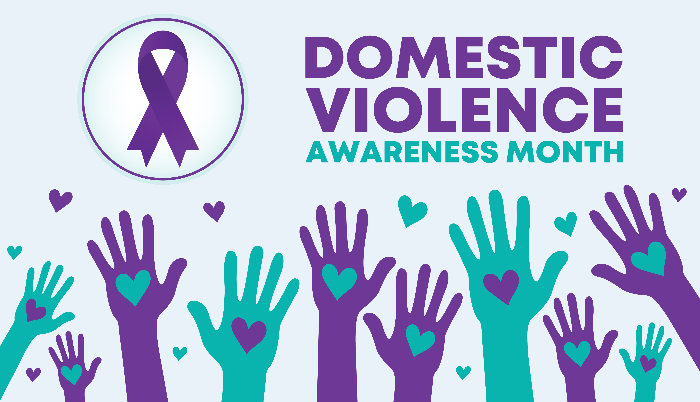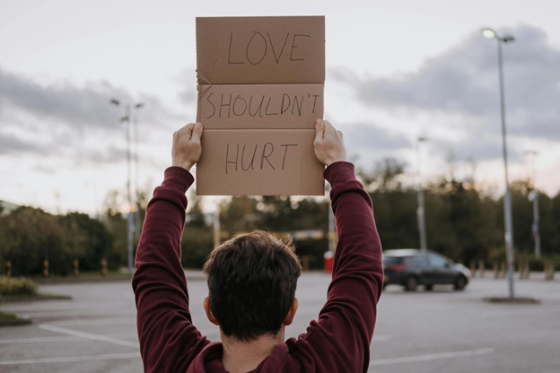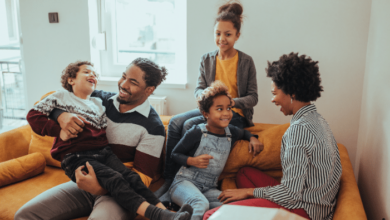Understanding And Raising Awareness About Domestic Violence
October Is Domestic Violence Awareness Month

Domestic violence (DV) is a pattern of abusive behavior used by one person to gain control over another in an intimate relationship. It can take many forms, including physical, emotional, sexual, and financial abuse, and affects individuals regardless of age, gender, or background. While many people think that DV only impacts women, gender, age, and background don’t matter.
Anyone can experience this type of abuse. In fact, in the United States alone, one-half of all women and about 40% of all men experience severe intimate partner physical violence, sexual violence, or stalking in their lifetime. Awareness efforts are vital to shine a light on the often-hidden problem and encourage communities to take action to support those impacted by DV.
What is Domestic Violence?
DV is a complex issue that involves a range of abusive behaviors aimed at exerting control over a partner. It’s not just about physical harm; it includes a variety of manipulative tactics that create fear, dependency, and emotional trauma for victims. These include:
- Physical abuse: Hitting, slapping, or any form of physical harm.
- Emotional/psychological abuse: Verbal attacks, manipulation, gaslighting, or making someone feel worthless.
- Sexual abuse: Forcing or coercing sexual acts without consent.
- Financial abuse: Controlling a partner’s financial resources or preventing them from working.
- Digital abuse: Using technology to harass, stalk, or control someone’s online activity.
The Impact of Domestic Violence
If you’ve experienced DV, then you know it isn’t over when it’s “over.” The impacts extend far beyond the immediate harm inflicted on the victim. Survivors often suffer from long-term mental, physical, and emotional health problems, such as anxiety, depression, chronic pain, and even PTSD. The toll on their overall well-being is immense and can persist for years.
And even if the DV isn’t directed at kids, it impacts them immensely. Children who live in households with DV often struggle with emotional and behavioral issues, including increased aggression, difficulty forming healthy relationships, and mental health challenges that can carry into adulthood.
But DV doesn’t just impact individuals and families; it’s incredibly challenging to deal with on a national level. The healthcare and social services systems bear the financial costs of treating injuries, providing mental health care, and supporting survivors through shelters and other services. Domestic violence costs billions in healthcare expenses each year. The only way to reduce these costs is better prevention and intervention methods.
Warning Signs and Red Flags
Domestic violence is not always easy to identify, but there are common warning signs that someone may be in an abusive relationship. Behavioral changes in victims can include increased anxiety, isolation from friends and family, and visible fear of their partner. These shifts in behavior are often the result of the abuser’s tactics.
Common tactics used by abusers include:
- Isolation: Cutting off the victim’s contact with loved ones or controlling their social interactions.
- Manipulation: Gaslighting, blame-shifting, or making the victim feel responsible for the abuse.
- Threats: Threatening to harm the victim, their loved ones, or even pets.
Recognizing an unhealthy relationship involves looking for these red flags. If someone constantly apologizes for their partner’s behavior, has unexplained injuries, or withdraws from previously enjoyed activities, they may be experiencing abuse. Trusting your instincts and reaching out if you suspect someone is in danger is essential.
Myths and Truths about Domestic Violence
There are many myths about domestic violence, such as the belief it only happens in certain socioeconomic groups or that victims can quickly leave their abuser. Let’s examine some of these myths and discover the truth about DV.
Myth: Domestic violence only happens in poor or uneducated families.
Domestic violence does not discriminate based on socioeconomic status, education, or background. It can happen to anyone, regardless of their money or where they live. While it may be more visible in lower-income communities due to fewer resources for privacy, wealth, and education, do not make someone immune to abuse.
Myth: If there are no physical injuries, it’s not abuse.
Abuse isn’t limited to physical harm. Emotional, psychological, sexual, and financial abuse can be just as damaging, if not more so, because they can erode a victim’s sense of self and autonomy over time.
Emotional abuse, such as constant criticism, manipulation, or gaslighting, can profoundly affect a person’s mental health and self-esteem, even though there may be no visible scars. Many survivors of DV report that the emotional wounds last longer than the physical ones.
Myth: Victims could leave if they wanted to.
Leaving an abusive relationship is much more complicated than it seems. Many victims face financial dependence, emotional manipulation, fear of retaliation, or threats to their children or loved ones. In some cases, leaving can escalate the violence, putting the victim in even greater danger.
Additionally, abusers often isolate their victims from support systems, making it harder to access help or feel empowered to leave. The decision to go requires a plan, resources, and, most importantly, safety.
Myth: Domestic violence is a private matter, and outsiders shouldn’t get involved.
Domestic violence affects entire communities, not just the individuals in the relationship. Ignoring signs of abuse or treating it as a “private matter” allows it to continue unchecked, endangering not only the victim but potentially others as well.
Friends, family, neighbors, and co-workers can play a crucial role in recognizing the signs of DV and offering support. By standing up and intervening, we create a culture that does not tolerate abuse.
Myth: It’s only abuse if the abuser is violent all the time.
Domestic violence often follows a cycle, where periods of tension and abuse are followed by periods of calm or even affection, known as the “honeymoon phase.” This cycle can make it difficult for victims to recognize they are in an abusive relationship.
The intermittent nature of the violence can lead victims to believe that things will improve or that the abuse isn’t severe. However, abuse, even if occasional, is still harmful and can escalate over time.

How to Support a Domestic Violence Survivor
Supporting someone who has experienced domestic violence requires empathy, patience, and understanding. The most important thing you can do is listen without judgment. Survivors often feel isolated and misunderstood, so offering a safe space to talk can be incredibly valuable.
In addition to emotional support, practical assistance is essential. Helping a survivor create a safety plan, which may include an exit strategy and identifying safe places to go, can make a significant difference. Providing resources like hotline numbers, information about local shelters, or referrals to counseling services also plays a vital role in their recovery.
Legal Protections and Resources
There are various legal protections available to domestic violence survivors, including restraining orders, which can help keep abusers away. Laws vary by state, but survivors can obtain emergency protective orders quickly and without a lengthy court process in many areas. These orders provide immediate relief while more permanent legal solutions are pursued.
Local and national helplines, such as the National Domestic Violence Hotline, offer 24/7 support and can connect survivors with resources like shelters, advocacy groups, and legal assistance. Law enforcement also plays a critical role in helping victims, although trust in the system can vary based on past experiences.
Survivors should know the court system can help with issues like child custody, property division, and ongoing protection. Legal advocacy organizations are available to guide survivors through the often complex and intimidating legal process.
We Can Help: The Importance of Domestic Violence Awareness
Raising awareness about domestic violence is an essential step toward creating a world where everyone can live free from fear and harm. By staying informed, being vigilant, and offering support to those affected by DV, we can all play a role in ending this cycle of abuse. Building communities that value respect, safety, and empathy is not just an ideal: It’s an achievable goal.
Do you want further advice about how to stop DV? Do you have experience with helping survivors? Let us know in the comments. Communities, including our online communities, play a significant role in intervention. For more information on the tough stuff in family life, check out our advice on the Support for Stepdads blog.






